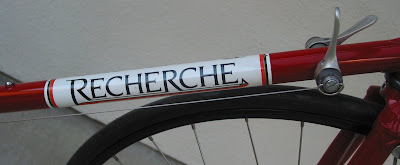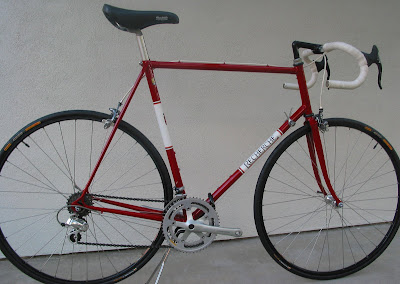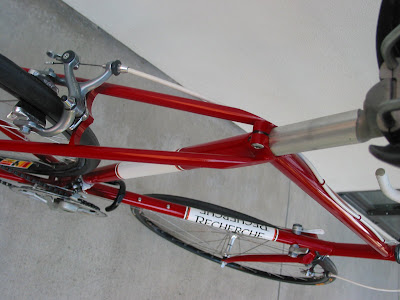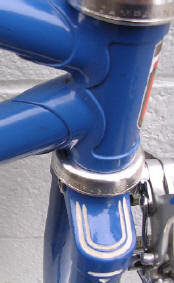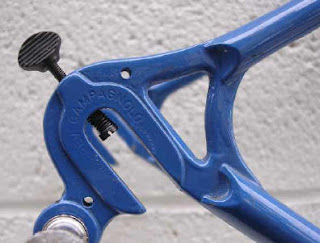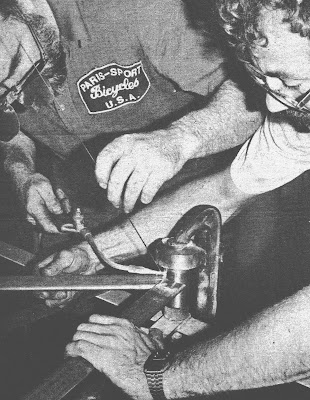
Myself and Mike Melton (Right) building the aero frames.
Looking through an old scrapbook last evening I came across a story that Velo-News did in February 1980.
They did a pretty good piece of unbiased investigative reporting into some Aerodynamic frames I built for the US Team Time Trial riders for the 1979 World Championships. The whole episode turned into a huge fiasco, and after many people putting a great deal of effort and expense into the project the bikes were never used.
I came to work for Paris Sport in New Jersey in January 1979. At the time, Mike Fraysee co-owner of Paris Sport, was also President of the US Cycling Federation, the governing body of competitive cycling in the US.
The big new thing in bicycles at that time was aerodynamic frames, and it was suggested I build such frames for the US Team Time Trial squad. I had built a few aero frames in England the previous year by modifying round tubing to make it aero shape. No one was manufacturing proper tubes at the time.
I approached the English Reynolds Tube Company at the New York Bicycle Show in February 1979 and they agreed to produce the aero tubes. I had enjoyed a close working relationship with Reynolds, having been in from the start of their development of 753 tubing in the mid 1970s and built some early 753 test frames for them.
In March 1979 I flew back to England to meet with engineers at Reynolds and together we came up with design for an aero tube that was tear-drop shape in cross section. The tooling alone to draw these special tubes was made at a cost around $30,000. Remember this was 1979, thirty grand was a lot of money then.
The tubing took a few months to produce and when it arrived in New Jersey, time was running close to when the bikes would be needed. Because of this Mike Melton a top US framebuilder was brought in to help me build them. Mike and I burned the mid-night oil for a week without pay, I should add, to produce five frames. Four for the team and one spare.
The bikes were tried out by the team but were never used in competition and never even made it to the World Championship. One of the reasons the riders gave for their non use; the bikes handled badly.
You have to remember at the time I was a relatively unknown framebuilder in the US and you could say stuff like that. Obviously, the bikes were tested before they went out and they handled fine. Also at the same time Reynolds sent aero tubing to me, they sent some to French bicycle manufacturer, Gitane. They built a frame for Bernard Hinault who won a time trial stage in the Tour de France on it. He also went on to win the Tour that year.
The whole episode was a politically driven fiasco that I deeply regretted getting into, and it made me look bad with Reynolds; after all theirs was the biggest financial loss. The final kicker came later when the bikes were stripped and the Campagnolo parts were stolen. Riders and/or USCF officials were suspected.
A small consolation came later when a track bike version of the same aero tubing was ridden by an 18 year old Greg Lemond when he took the gold in the Junior World Pursuit Championship in 1979.
I scanned the article and you can read it as a PDF file. It goes into more detail than I have here. (You may want to print it, it is a little long to read on screen.) It is in three parts; there is my side of the story. The riders’ side, with comments by Mike Fraysee, and the story about the theft of parts. After reading the story again, I wondered what ever happened to the frames?
Either they ended up in a dumpster somewhere or if someone reading this has one in their garage, please send it to me. I would put it on eBay and recoup a little of my losses from all those years ago.
 Fri, April 13, 2007
Fri, April 13, 2007  Here is a very early California built custom ‘dave moulton.’ Built in January 1981 while I was working for Masi, having just moved there three months earlier.
Here is a very early California built custom ‘dave moulton.’ Built in January 1981 while I was working for Masi, having just moved there three months earlier.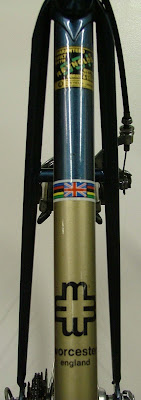
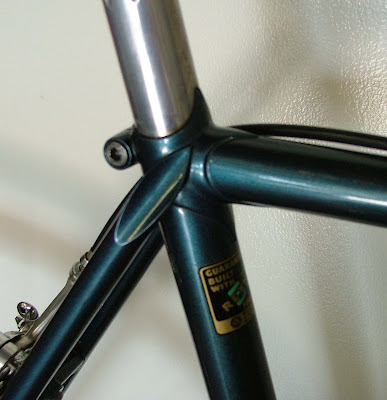 The concave seat stay caps, made by brazing in place an off-cut of head tube would become typical of my custom frames. Also used on many frames that followed was the slim-line fork crown. Investment cast in Italy by Microfusioni, (The company that cast Cinelli crowns and BB shells.) and imported by the British company, Saba.
The concave seat stay caps, made by brazing in place an off-cut of head tube would become typical of my custom frames. Also used on many frames that followed was the slim-line fork crown. Investment cast in Italy by Microfusioni, (The company that cast Cinelli crowns and BB shells.) and imported by the British company, Saba. There is no engraving on the fork crown and bottom bracket of these 1981 custom frames, that started the following year in 1982 when I started building my own frames full time.
There is no engraving on the fork crown and bottom bracket of these 1981 custom frames, that started the following year in 1982 when I started building my own frames full time.  Dave Moulton | Comments Off |
Dave Moulton | Comments Off | 
















